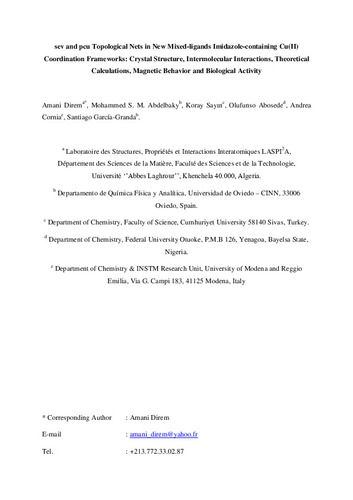Sev and pcu topological nets in one-pot newly synthesized mixed-ligand imidazole-containing Cu(II) coordination frameworks: Crystal structure, intermolecular interactions, theoretical calculations, magnetic behavior and biological activity
Autor(es) y otros:
Fecha de publicación:
Versión del editor:
Citación:
Descripción física:
Resumen:
Novel mixed-ligands coordination frameworks, namely [Cu(Imd)3(H2Cit)] (1) and [Cu(Imd)2(HCit)]·(HImd) (2) (with Imd = imidazole, H2Cit = dihydrogencitrate, HCit = hydrogencitrate and HImd = imidazolium) were obtained as a result of the reaction between imidazole, citric acid and copper chloride. The complexes were structurally characterized by elemental analysis, FTIR spectroscopy and X-ray diffraction. The two structures were found to be connected through 3D hydrogen-bonding networks examined by means of the Hirshfeld surface analysis which highlighted the presence of O−H···O, N−H···O and C−H···O H-bonds together with the π···lp interactions. A topological analysis of the underlying nets corresponding to the two hydrogen-bonded frameworks was carried out. Moreover, quantum chemical calculations were performed using the HF method with 6-31G(d) and LANL2DZ levels in the gas phase, and therefore the optimized structures, the IR, 1H NMR, 13C NMR spectra, the MEP maps and the electronic structure descriptors were examined in detail. Furthermore, the magnetic properties of (1) and (2) were also investigated. The complexes showed remarkable antimicrobial and antifungal inhibition activities.
Novel mixed-ligands coordination frameworks, namely [Cu(Imd)3(H2Cit)] (1) and [Cu(Imd)2(HCit)]·(HImd) (2) (with Imd = imidazole, H2Cit = dihydrogencitrate, HCit = hydrogencitrate and HImd = imidazolium) were obtained as a result of the reaction between imidazole, citric acid and copper chloride. The complexes were structurally characterized by elemental analysis, FTIR spectroscopy and X-ray diffraction. The two structures were found to be connected through 3D hydrogen-bonding networks examined by means of the Hirshfeld surface analysis which highlighted the presence of O−H···O, N−H···O and C−H···O H-bonds together with the π···lp interactions. A topological analysis of the underlying nets corresponding to the two hydrogen-bonded frameworks was carried out. Moreover, quantum chemical calculations were performed using the HF method with 6-31G(d) and LANL2DZ levels in the gas phase, and therefore the optimized structures, the IR, 1H NMR, 13C NMR spectra, the MEP maps and the electronic structure descriptors were examined in detail. Furthermore, the magnetic properties of (1) and (2) were also investigated. The complexes showed remarkable antimicrobial and antifungal inhibition activities.
ISSN:
Patrocinado por:
The financial support from Université Abbes Laghrour Khenchela (Algeria), TUBITAK ULAKBIM, High Performance and Grid Computing Center (TRUBA Resources, Turkey), Spanish MINECO MAT2016-78155-C2-1-R, FPI grant BES-2011-046948 to MSM.A., Gobierno del Principado de Asturias (GRUPIN14-060) and FEDER are acknowledged.
Colecciones
- Artículos [37541]
- Investigaciones y Documentos OpenAIRE [8416]
- Química Física y Analítica [639]
Ficheros en el ítem





